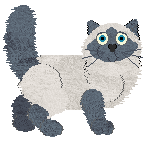A very laid-back breed, the ideal Ragdoll is a well-balanced cat with no extreme features. They are a medium to large, moderately longhaired, blue-eyed pointed cat. It is an affectionate and intelligent cat, giving the impression of graceful movement and subdued power, striking in appearance. Their calm and placid temperament is legendary—and so are their origins. In the early 1960s, Ann Baker of Riverside, California found a stray with long white hair and named it Josephine. She let her run loose, and as happens with outdoor cats, Josephine was hit by a car. The damage was fortunately minor, but for the rest of her life she had a tendency to “flop” when picked up—just like a rag doll. When she was impregnated by one of Ann Baker’s other cats, her kittens supposedly inherited this trait, although this is not how genetics works.
Baker thought that this placid temperament was the ideal foundation for a new breed, and started breeding using stray cats, her own Persians, as well as lilac Balinese and Birmans. Although her cats garnered interest amongst fanciers, Baker refused to sell her cats to anyone and in 1971, she formed the International Ragdoll Cat Association so that she could franchise the breed to her standards, limiting breeders to one per state and insisting she receive all profits. IRCA cats were not allowed to be registered in any other organization, and breeders were subjected to all manner of inspections and regulations. In 1975, Denny and Laura Dayton were fed up and took their Ragdolls to other organizations, drafting the standard that would be accepted globally. Baker retaliated by copyrighting the name Ragdoll and years of litigation between the Dayton faction, Baker’s IRCA, and a number of other rival factions followed. In the years since Baker’s death in 1997, the Ragdoll community has come together and collectively tried to bridge the barriers left by their bizarre and tangled breed history, and are now as respected as any other breed on the show bench.
Type & judging remarks
The head is a broad, modified wedge in keeping with the heavy and strong quality of the rest of the cat. Shading in this breed can be very heavy, to better emphasize the white markings.








 in the mitted (towards maximum being most preferred), bicolour (strict), or van pattern. Asymmetrical facial markings are allowed but not preferred.
in the mitted (towards maximum being most preferred), bicolour (strict), or van pattern. Asymmetrical facial markings are allowed but not preferred.






